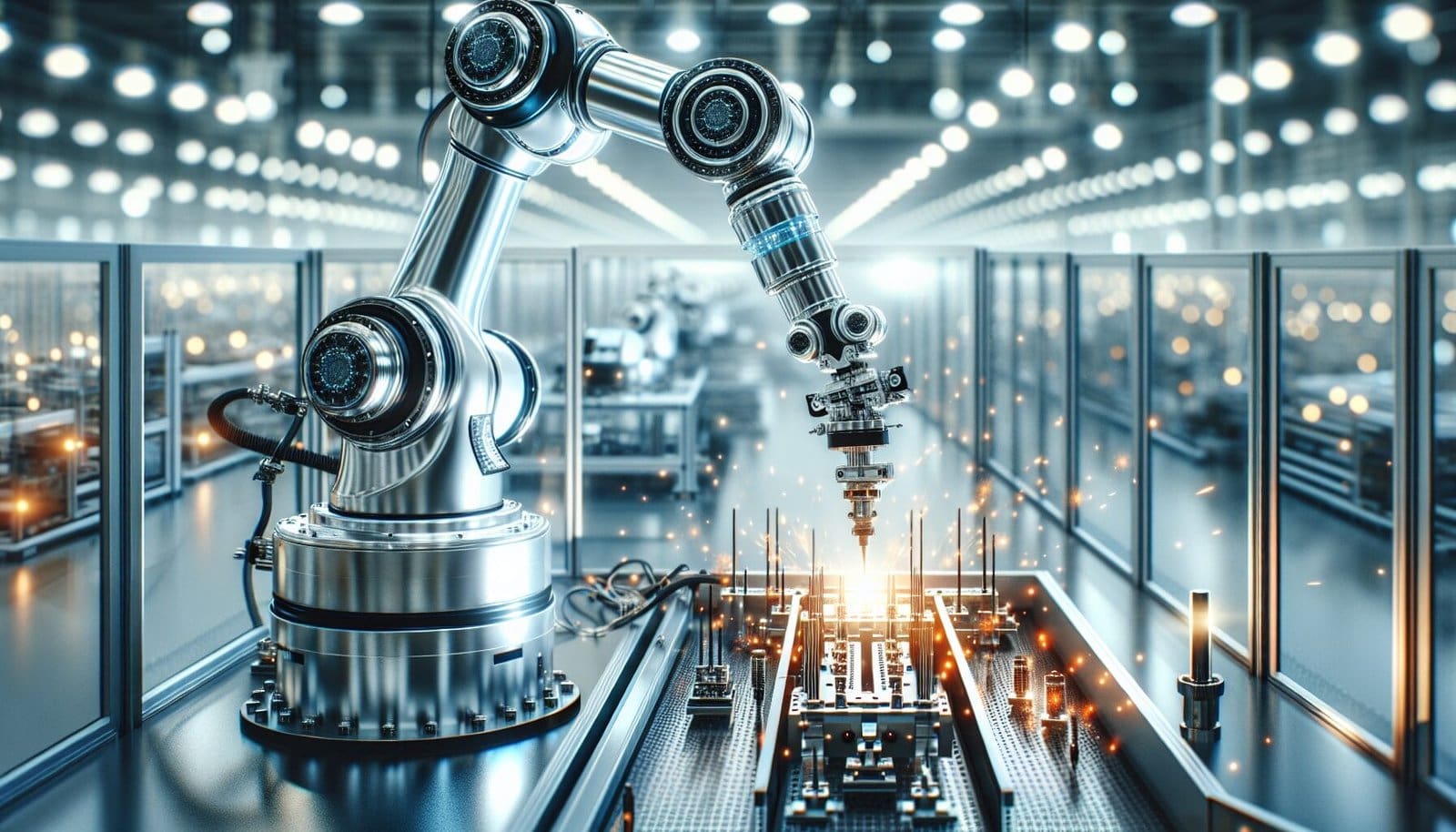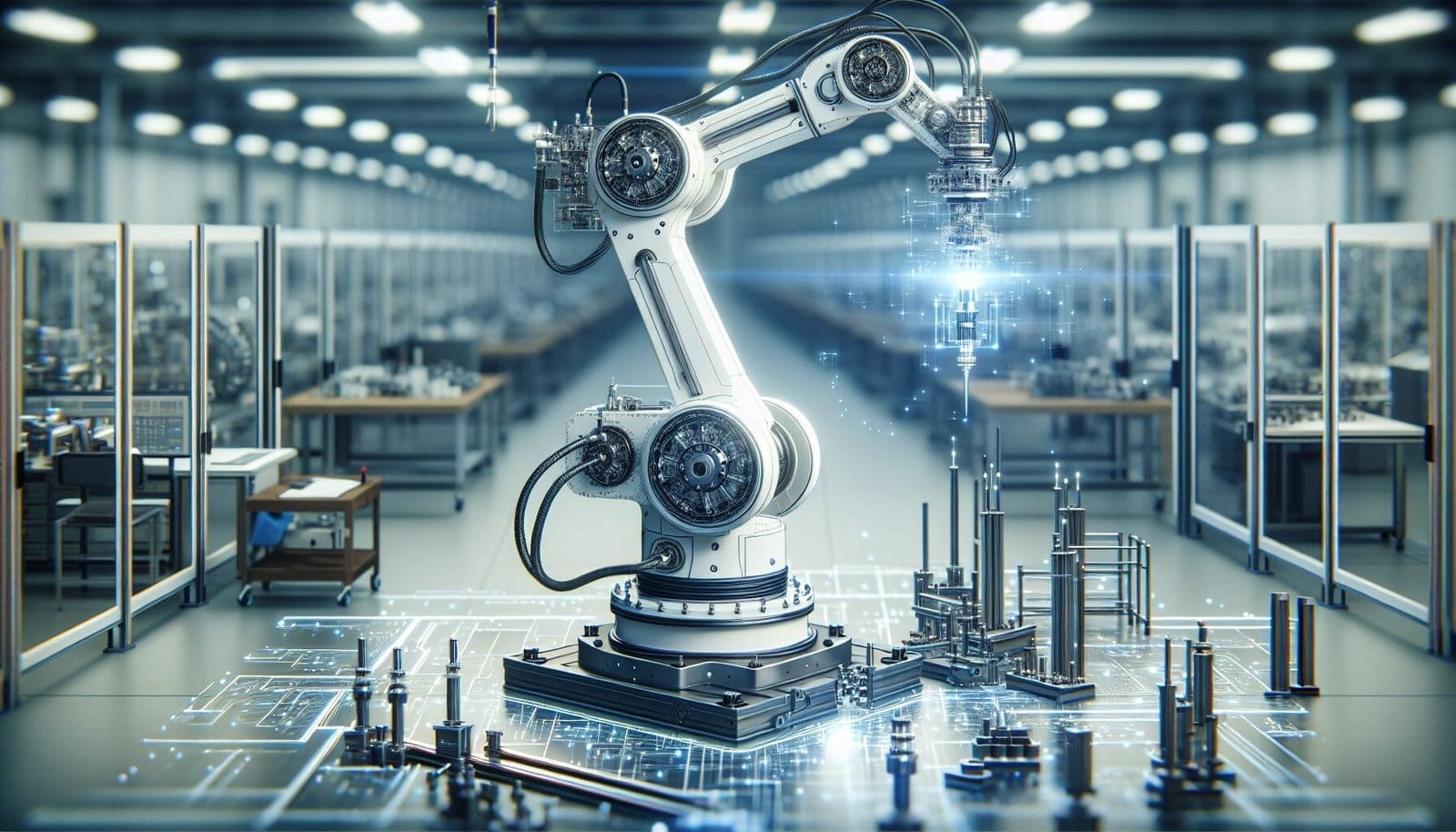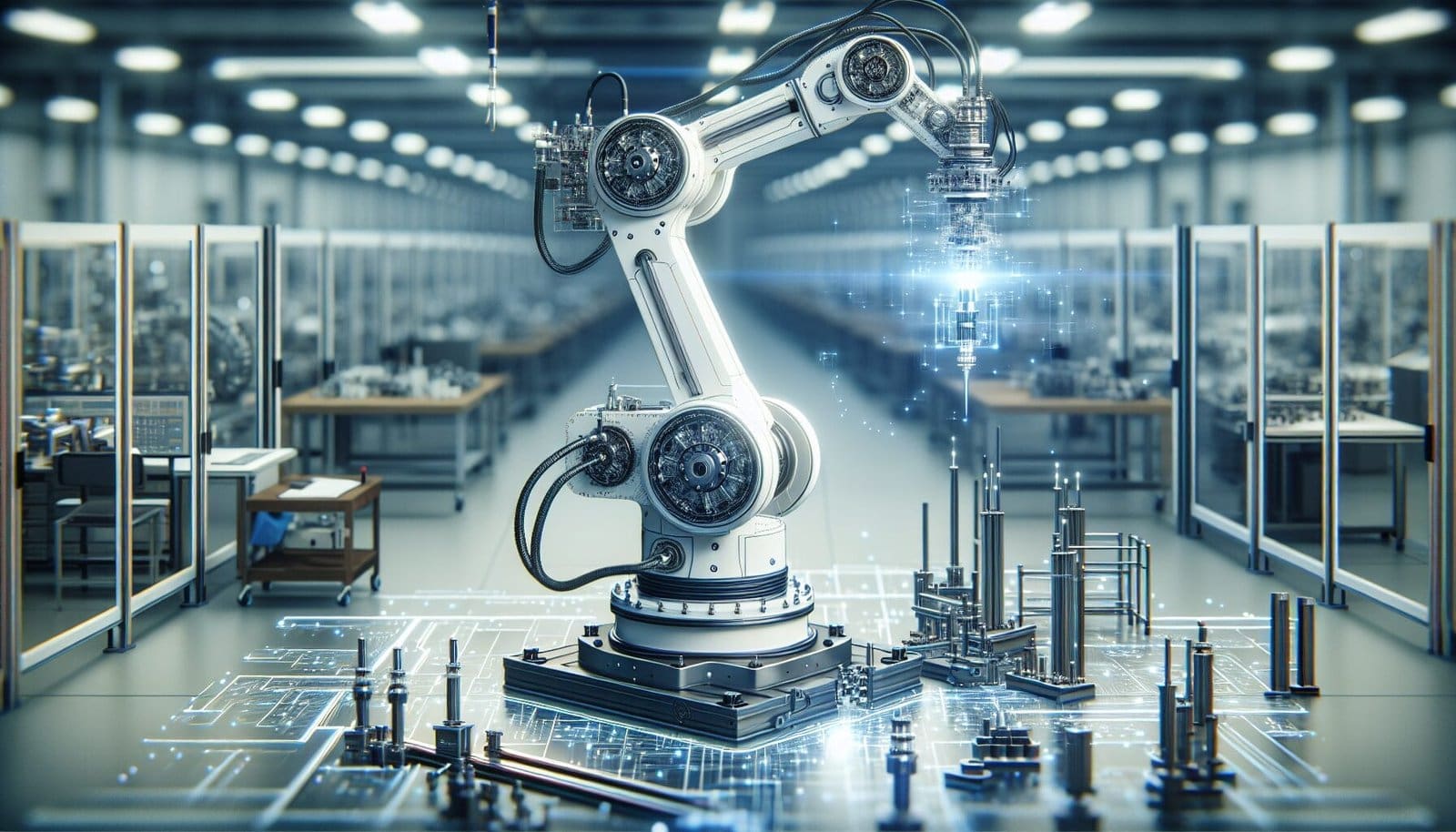Artificial Intelligence (AI) has revolutionized various industries, and its potential in manufacturing processes is no exception. From streamlining automation to enhancing quality control, AI applications have seeped into every aspect of the manufacturing realm. In this article, we embark on a fascinating journey to explore the role of AI in manufacturing processes, uncovering how this technology is transforming the way goods are produced, improving efficiency and productivity along the way. Get ready to discover the countless possibilities AI offers to manufacturers, as we delve into its various applications in this exciting field.
The Basics of Artificial Intelligence in Manufacturing
Introduction to Artificial Intelligence
Artificial Intelligence (AI) is a technology that has been rapidly evolving in recent years and has found its way into various industries, including manufacturing. AI refers to the development of computer systems that can perform tasks that would typically require human intelligence, such as problem-solving, learning, and decision-making. In the context of manufacturing, AI is being applied to automate processes, improve productivity, enhance quality control, and optimize supply chain management. It is transforming the way manufacturers operate and offering new opportunities for growth and efficiency.
Overview of Manufacturing Processes
Manufacturing processes involve a series of steps and activities that transform raw materials into finished products. These processes can vary depending on the industry and the type of product being manufactured. Common manufacturing processes include assembly lines, quality control, inventory management, and logistics. These processes are often complex and require careful planning, coordination, and monitoring to ensure smooth operations and high-quality output.
How AI is Transforming Manufacturing
AI is revolutionizing the manufacturing industry by enabling greater automation, optimization, and efficiency. The technology has the potential to significantly improve the speed and accuracy of various manufacturing processes, resulting in increased productivity and reduced costs. AI can automate repetitive tasks, analyze large amounts of data to identify patterns and trends, and make real-time decisions based on the insights gathered. AI is also enabling predictive maintenance, where machines can detect potential issues before they occur, thus reducing downtime and improving overall equipment effectiveness.
Benefits of AI in Manufacturing
The integration of AI in manufacturing brings numerous benefits to businesses. One significant advantage is increased productivity. By automating processes and leveraging AI-driven optimization techniques, manufacturers can streamline operations, minimize waste, and improve overall efficiency. AI can also enhance quality control initiatives by automating defect detection and classification, thereby ensuring that every product meets the desired standards. Additionally, AI-powered predictive maintenance improves equipment reliability and reduces maintenance costs. Overall, AI in manufacturing leads to cost savings, improved product quality, and better customer satisfaction.
AI-Driven Process Automation
Role of AI in Process Automation
AI plays a crucial role in process automation by enabling machines to perform tasks that would otherwise require human intervention. It involves the use of AI algorithms and machine learning techniques to analyze data, make decisions, and execute actions. This capability allows manufacturers to automate repetitive and manual tasks, streamline production processes, and increase operational efficiency. By eliminating human error and reducing labor-intensive tasks, AI-driven process automation improves productivity and reduces costs.
Implementing AI in Assembly Lines
AI is revolutionizing assembly line operations by automating tasks traditionally performed by human workers. With the integration of AI-powered robotics, machines can handle complex assembly processes, improving precision, and reducing the time required to complete each task. AI also enables real-time monitoring and control of the assembly line, allowing manufacturers to identify and address bottlenecks, optimize production flow, and minimize downtime. The implementation of AI in assembly lines leads to higher productivity, improved quality, and enhanced worker safety.
Automating Quality Control with AI
Quality control is a critical aspect of manufacturing to ensure that products meet the required standards and specifications. AI is transforming quality control by automating defect detection and classification, eliminating the need for manual inspection. By analyzing large volumes of data and images, AI algorithms can identify even the smallest defects with high accuracy. This automation not only improves the efficiency of the quality control process but also reduces the time and cost associated with manual inspection. With AI, manufacturers can ensure consistent product quality and minimize the risk of defective products reaching the market.
AI-Enabled Predictive Maintenance
Predictive maintenance is a proactive approach to equipment maintenance that involves predicting and preventing failures before they occur. AI plays a crucial role in implementing predictive maintenance strategies by analyzing real-time data from sensors and machines to detect patterns and anomalies. By monitoring the condition of equipment, AI algorithms can identify signs of potential failures and trigger maintenance actions accordingly. This approach helps minimize unplanned downtime, increase equipment reliability, and optimize maintenance schedules. With AI-enabled predictive maintenance, manufacturers can reduce costs associated with reactive maintenance and extend the lifespan of their assets.

Enhancing Productivity with AI in Manufacturing
Optimizing Production Planning and Scheduling
Production planning and scheduling are critical components of manufacturing operations that impact overall productivity and efficiency. AI can optimize these processes by analyzing historical data, demand forecasts, and resource availability to generate optimal production plans. By considering various factors such as production capacity, material availability, and customer demand, AI algorithms can suggest the most efficient production schedules, minimizing idle time and maximizing throughput. This optimization leads to improved resource utilization, reduced lead times, and enhanced overall productivity.
AI for Inventory Management and Supply Chain
Inventory management and supply chain operations are complex and can be challenging to optimize. AI offers significant benefits in these areas by providing real-time visibility into inventory levels, demand patterns, and supplier performance. By analyzing historical data and external factors such as market trends and weather conditions, AI algorithms can generate accurate demand forecasts, enabling manufacturers to optimize inventory levels and minimize stockouts or overstocks. AI can also automate replenishment processes, optimize transportation routes, and improve supplier selection, resulting in a more efficient and cost-effective supply chain.
Improving Equipment Utilization with AI
Efficient equipment utilization is crucial for maximizing production capacity and reducing idle time. AI can help improve equipment utilization by analyzing data from sensors and systems to identify potential bottlenecks and optimize equipment scheduling. By monitoring the performance of each machine and identifying patterns of underutilization or inefficiency, AI algorithms can recommend adjustments to production schedules, preventive maintenance, or process optimization. By proactively addressing equipment utilization challenges, manufacturers can increase productivity, reduce costs, and improve overall operational efficiency.
AI-Driven Performance Monitoring
Monitoring and optimizing performance is essential for maintaining and improving manufacturing operations. AI-driven performance monitoring involves collecting and analyzing real-time data from various sources to identify areas for improvement and make data-driven decisions. By integrating AI with the existing data infrastructure, manufacturers can gain insights into production metrics, quality indicators, and equipment performance. AI algorithms can then analyze this data to identify deviations from set targets or trends that may indicate potential issues. The insights gained from AI-driven performance monitoring allow manufacturers to take proactive actions, continuously improve processes, and optimize overall performance.
Quality Control and Inspection Techniques with AI
AI for Defect Detection and Classification
Ensuring product quality is paramount in the manufacturing industry, and defect detection and classification are crucial aspects of quality control. AI is revolutionizing these processes by automating the identification and categorization of defects in products. By analyzing images, data, and sensors, AI algorithms can identify even minor defects with a high level of accuracy, reducing the reliance on manual inspection. This automation improves efficiency, consistency, and speed in defect detection, enabling faster remediation and reducing the risk of defective products reaching the market.
Computer Vision in Quality Control
Computer vision is a subset of AI that focuses on analyzing and interpreting visual data. In quality control, computer vision plays a significant role in automating inspection processes and detecting defects. By capturing images or videos of products, computer vision algorithms can analyze the visual data and identify anomalies or faults. Computer vision can detect defects in different forms, such as scratches, deformations, or color variations, allowing manufacturers to address quality issues promptly. By integrating computer vision with AI, manufacturers can achieve high-quality standards consistently and efficiently.
Implementing AI in Non-Destructive Testing
Non-destructive testing (NDT) is a critical process in manufacturing that aims to detect flaws or defects in materials or components without causing damage. AI has the potential to transform NDT by automating inspection techniques and improving defect detection accuracy. By analyzing data from sensors, ultrasound, X-ray, or thermal imaging, AI algorithms can identify and classify defects or anomalies. This automation not only improves the efficiency of the NDT process but also reduces the risk of human error. By implementing AI in NDT, manufacturers can enhance quality assurance and reduce the likelihood of costly rework or product recalls.
AI-Enhanced Inspection and Testing Procedures
AI can enhance various inspection and testing procedures in manufacturing by automating complex tasks and improving accuracy. AI algorithms can analyze large volumes of data and apply pattern recognition techniques to identify anomalies or deviations from set standards. In combination with machine learning, AI can continuously improve its predictive capabilities and adapt to changing conditions. By integrating AI into inspection and testing procedures, manufacturers can increase efficiency, reduce the reliance on manual labor, and ensure consistent product quality.

AI in Robotics and Autonomous Systems
Role of AI in Robotic Process Automation
Robotic process automation (RPA) involves the use of robots or computer software to automate repetitive and rule-based tasks. AI plays a crucial role in RPA by enabling robots to make decisions and perform tasks that would typically require human intelligence. By incorporating AI algorithms, robots can analyze data, learn from experience, and adapt to changing situations. This capability allows robots to perform complex tasks, such as picking and placing objects, assembly processes, or material handling. AI-driven RPA in manufacturing improves productivity, reduces errors, and enhances overall operational efficiency.
Collaborative Robots (Cobots) and AI Integration
Collaborative robots, also known as cobots, are designed to work alongside human workers, complementing their capabilities and enhancing productivity. AI integration is a key enabler for cobots, allowing them to perform tasks that require human-like perception, decision-making, and adaptability. Cobots equipped with AI algorithms can understand and respond to human instructions, navigate complex environments, and perform intricate assembly or manufacturing operations. By collaborating with cobots, human workers can focus on tasks that require creativity, problem-solving, or complex decision-making. The integration of AI with cobots offers a more efficient, safe, and collaborative manufacturing environment.
AI-Driven Robotics for Hazardous Environments
Manufacturing environments that involve hazardous conditions, such as extreme temperatures, toxic substances, or physical risks, can benefit from AI-driven robotics. AI algorithms can be used to develop robots that are capable of operating in these challenging environments. By integrating AI with robotics, these machines can perform tasks that would be dangerous or impossible for humans. For example, AI-driven robots can be used for tasks such as handling hazardous materials, inspecting confined spaces, or performing maintenance in dangerous locations. This integration of AI and robotics enhances safety, reduces risks, and improves the efficiency of operations in hazardous environments.
Challenges and Future of AI in Robotics
While AI has brought significant advancements to robotics in manufacturing, several challenges still need to be addressed. One challenge is the integration and compatibility of different AI technologies and robotics systems. As AI continues to develop, ensuring interoperability and seamless integration between different platforms and systems is crucial. Additionally, ethical considerations surrounding AI in robotics, such as job displacement and human supervision, need to be carefully addressed. The future of AI in robotics holds great potential for further advancements in manufacturing automation, human-robot collaboration, and the development of more sophisticated and intelligent robotic systems.
Applying AI in Supply Chain Management
Optimizing Demand Forecasting with AI
Demand forecasting plays a vital role in supply chain management by enabling manufacturers to plan and allocate resources effectively. AI has the capability to optimize demand forecasting by analyzing historical data, market trends, and external factors. By leveraging AI algorithms, manufacturers can generate accurate and reliable demand forecasts, improving inventory management, reducing stockouts or overstocks, and optimizing production schedules. AI-based demand forecasting models can adapt to changing market conditions and supply chain dynamics, enabling manufacturers to respond proactively to demand fluctuations and achieve better supply chain performance.
AI-Enabled Warehouse Management
Efficient warehouse management is essential for optimizing inventory levels, minimizing costs, and ensuring timely order fulfillment. AI offers significant benefits in warehouse management by automating and optimizing various processes. AI algorithms can analyze historical data, order patterns, and operational factors to optimize product placement, inventory allocation, and picking routes. By integrating AI with warehouse management systems, manufacturers can reduce labor costs, improve order accuracy, and enhance overall operational efficiency. AI-enabled warehouse management ensures efficient utilization of warehouse space, streamlined workflows, and improved customer satisfaction.
AI for Logistics and Route Optimization
Logistics and transportation are critical components of supply chain management that impact cost, delivery times, and customer satisfaction. AI plays a vital role in optimizing logistics operations by analyzing data from various sources, such as GPS, traffic, weather, and historical delivery patterns. By integrating AI algorithms, manufacturers can optimize transportation routes, minimize fuel consumption, and enhance delivery schedules. AI can also enable real-time monitoring and tracking of shipments, providing visibility and transparency across the supply chain. With AI-driven logistics and route optimization, manufacturers can achieve cost savings, faster delivery times, and improved customer service.
Using AI in Supplier Selection and Relationship Management
Selecting and managing suppliers is a complex and critical task in supply chain management. AI can assist in supplier selection by analyzing multiple factors, such as price, quality, reliability, and capacity. By leveraging AI algorithms, manufacturers can evaluate and rank potential suppliers based on predefined criteria, enabling informed decision-making and reducing risks. AI can also enhance supplier relationship management by analyzing historical data and supplier performance to identify potential issues or areas for improvement. With AI-enabled supplier selection and relationship management, manufacturers can establish strategic partnerships, improve supply chain resilience, and achieve better overall supply chain performance.
AI and Predictive Maintenance in Manufacturing
Introduction to Predictive Maintenance
Predictive maintenance is an approach to maintenance that involves predicting equipment failures before they occur, allowing maintenance actions to be taken proactively. Traditional maintenance strategies rely on scheduled maintenance or reactive maintenance, leading to unnecessary downtime or costly repairs. Predictive maintenance, powered by AI, leverages machine learning algorithms and real-time data to identify patterns or anomalies that indicate impending failures. This proactive approach enables manufacturers to schedule maintenance activities at the optimal time, reduce unplanned downtime, minimize repair costs, and maximize equipment uptime.
Benefits of AI in Predictive Maintenance
The integration of AI in predictive maintenance brings several benefits to manufacturers. One significant advantage is the ability to detect potential equipment failures before they occur. By analyzing real-time data from sensors or equipment systems, AI algorithms can identify patterns or anomalies that may indicate an impending failure. This early detection allows manufacturers to take preventive measures, such as scheduling maintenance or replacing components, before a failure disrupts operations. The proactive nature of predictive maintenance leads to increased equipment reliability, improved safety, and reduced maintenance costs.
Implementation of AI for Predictive Maintenance
Implementing AI for predictive maintenance involves several steps and considerations. The first step is data collection, where sensors or systems are used to capture real-time data from the equipment or processes. This data is then stored and analyzed using AI algorithms to detect patterns and anomalies. Machine learning techniques are applied to train the AI models and make accurate predictions based on historical data. The AI models can then be integrated with existing systems for real-time monitoring, alerting, and decision-making. Continuous monitoring, model refinement, and data feedback loops ensure the accuracy and effectiveness of the predictive maintenance system.
Case Studies and Success Stories
Numerous case studies and success stories highlight the effectiveness and benefits of AI in predictive maintenance. For example, a large automotive manufacturer implemented an AI-driven predictive maintenance system to improve the reliability of its production equipment. By analyzing real-time data from sensors and historical maintenance records, the AI system accurately predicted equipment failures, allowing the manufacturer to schedule maintenance activities proactively. This approach reduced unplanned downtime by 40% and increased equipment uptime by 20%, resulting in significant cost savings and improved operational efficiency.
Another success story involves a pharmaceutical company that integrated AI in its predictive maintenance strategy for critical manufacturing equipment. By leveraging AI algorithms to analyze sensor data and equipment performance, the company was able to detect anomalies and identify potential failures before they occurred. This proactive approach reduced equipment breakdowns, minimized production interruptions, and ensured reliable and consistent product quality. The implementation of AI in predictive maintenance enabled the company to optimize maintenance schedules, reduce costs, and enhance overall equipment effectiveness.
Addressing Safety and Quality Concerns with AI
AI Applications for Worker Safety
Worker safety is of utmost importance in manufacturing environments, and AI can play a significant role in addressing safety concerns. AI applications, such as computer vision and sensor technologies, enable real-time monitoring and detection of potential safety hazards. For example, AI-powered cameras can detect unsafe working conditions, such as blocked emergency exits or unauthorized personnel in restricted areas. AI algorithms can also analyze data from wearable devices to detect abnormal biometric readings or postures that may indicate potential risks. By integrating AI with safety systems, manufacturers can create safer working environments, reduce accidents, and protect the well-being of workers.
Ensuring Product Quality and Compliance
Ensuring product quality and compliance with regulatory standards is a top priority for manufacturers. AI can assist in this aspect by automating quality control processes, detecting defects, and ensuring consistency in product specifications. By integrating AI algorithms into quality control systems, manufacturers can identify deviations from desired quality standards, alert operators in real-time, and automatically reject or rework defective products. AI can also assist in compliance monitoring by analyzing production data and ensuring that processes adhere to regulatory requirements. By leveraging AI in quality control and compliance, manufacturers can enhance product quality, reduce non-compliance risks, and improve customer satisfaction.
Ethical Considerations in AI Adoption
The adoption of AI in manufacturing raises important ethical considerations that need to be addressed. One key consideration is job displacement. As AI automates repetitive tasks and improves efficiency, the role of human workers may change, leading to potential job losses. Manufacturers need to develop strategies to reskill or upskill their workforce to adapt to the changing work environment and ensure a smooth transition. Additionally, ethical considerations regarding data privacy and security are crucial. AI systems rely on large amounts of data, and manufacturers must ensure that data is collected, stored, and used responsibly and securely. Transparency, explainability, and accountability in AI adoption are also important ethical considerations to build trust among stakeholders.
Managing Data Security and Privacy
The integration of AI in manufacturing involves the collection, storage, and analysis of large amounts of data. Manufacturers must prioritize data security and privacy to protect sensitive information and comply with relevant regulations. Robust cybersecurity measures, such as encryption, access controls, and monitoring systems, need to be implemented to safeguard data from cyber threats. Manufacturers should also establish clear data governance policies and practices to ensure data is used ethically and appropriately. By prioritizing data security and privacy, manufacturers can mitigate risks, build trust with customers, and ensure compliance with data protection regulations.
The Role of AI in Lean Manufacturing
Applying AI for Waste Reduction
Lean manufacturing aims to eliminate waste and optimize processes to achieve maximum efficiency and customer value. AI can play a crucial role in lean manufacturing by analyzing data and identifying opportunities for waste reduction. By utilizing AI algorithms, manufacturers can analyze production data, identify inefficiencies, and suggest process improvements. For example, AI can optimize material usage, reduce energy consumption, or streamline production flows, leading to waste reduction and cost savings. By applying AI in lean manufacturing, manufacturers can achieve operational excellence, increase productivity, and deliver high-quality products with minimal waste.
AI for Process Optimization
Process optimization is a fundamental concept in lean manufacturing to streamline operations and eliminate non-value-added activities. AI can significantly contribute to process optimization by analyzing data, identifying bottlenecks, and suggesting improvements to maximize efficiency. By integrating AI algorithms with process monitoring systems, manufacturers can analyze real-time data and identify process deviations or abnormalities. AI can also perform root cause analysis and recommend corrective actions to optimize process parameters or workflows. By leveraging AI for process optimization, manufacturers can improve cycle times, reduce lead times, and enhance overall operational efficiency.
AI-Enhanced Continuous Improvement
Continuous improvement is a key principle in lean manufacturing, aiming to continuously identify and implement improvements throughout the organization. AI can enhance continuous improvement initiatives by providing real-time insights and recommendations for operational enhancements. By analyzing data from various sources, including sensors, production systems, and quality control, AI algorithms can identify areas for improvement and suggest actionable measures. AI can also support the implementation and tracking of improvement initiatives, enabling manufacturers to measure the effectiveness of these efforts. With AI-enhanced continuous improvement, manufacturers can foster a culture of innovation, drive efficiency gains, and achieve sustainable growth.
Lean Six Sigma with AI
Lean Six Sigma is a methodology that combines lean manufacturing principles with Six Sigma quality management techniques. AI can augment the Lean Six Sigma approach by providing data-driven insights and predictive capabilities. By integrating AI algorithms into Lean Six Sigma initiatives, manufacturers can analyze historical data, identify root causes of defects or inefficiencies, and predict potential process deviations. AI can also assist in process monitoring, trend analysis, and statistical modeling, enabling manufacturers to achieve higher process capability and reduce process variation. The combination of Lean Six Sigma with AI accelerates problem-solving, increases process control, and drives continuous improvement efforts.
The Future of AI in Manufacturing
Emerging AI Technologies in Manufacturing
The future of AI in manufacturing holds exciting possibilities with the development of emerging AI technologies. One notable technology is the Internet of Things (IoT), where AI-powered devices can communicate and share data, enabling real-time monitoring and decision-making. Edge computing, which involves processing data at the device or machine level, enhances the speed and efficiency of AI algorithms. As AI continues to evolve, advanced techniques such as natural language processing and deep learning can further enhance manufacturing operations, enabling machines to understand and interpret complex data. The future of AI in manufacturing is characterized by increased connectivity, intelligent systems, and advanced data analytics.
AI-Driven Digital Twins
Digital twins, virtual representations of physical assets or processes, are revolutionizing the manufacturing industry. AI plays a crucial role in developing and utilizing digital twins to optimize operations and improve efficiency. By integrating AI algorithms with digital twin models, manufacturers can simulate and analyze various scenarios, monitor real-time data, and predict performance outcomes. AI-driven digital twins can enable predictive maintenance, optimize energy consumption, and streamline production processes. The use of AI in digital twins enables manufacturers to gain deeper insights into their operations, make data-driven decisions, and drive continuous improvement.
Human-Machine Collaboration in Manufacturing
AI is transforming the relationship between humans and machines in manufacturing, enabling closer collaboration and synergy. Rather than replacing human workers, AI is enhancing their capabilities and enabling them to focus on higher-value tasks that require creativity, problem-solving, and critical thinking. AI-powered machines can handle repetitive or physically demanding tasks, freeing up human workers to contribute their unique skills and expertise. The collaboration between humans and AI-driven machines leads to increased productivity, improved quality, and a safer working environment. The future of manufacturing involves seamless human-machine collaboration, where humans and machines work together, leveraging their respective strengths.
Overcoming Adoption Challenges
While AI holds immense potential for the manufacturing industry, there are challenges to overcome for widespread adoption. One challenge is the availability of skilled personnel who can understand and utilize AI technologies effectively. Manufacturers need to invest in training and upskilling their workforce to ensure they can make the most of AI capabilities. Another challenge is the integration and compatibility of AI systems with existing manufacturing infrastructure. Manufacturers need to ensure interoperability and ease of integration to avoid disruption and complexity. Data privacy and security, as well as ethical considerations, also need to be addressed to build trust and promote responsible AI adoption. By addressing these challenges, manufacturers can fully unlock the benefits of AI in manufacturing and pave the way for a more efficient and intelligent future.








